technical data SKODA CITIGO 2015 1.G Owner's Manual
[x] Cancel search | Manufacturer: SKODA, Model Year: 2015, Model line: CITIGO, Model: SKODA CITIGO 2015 1.GPages: 160, PDF Size: 23.1 MB
Page 3 of 160

Preface
You have opted for a ŠKODA – our sincere thanks for your confidence in us.
This Owner´s Manual contains instructions about the vehicle operation, important information about
safety, vehicle care, maintenance and self-help and technical vehicle data.
Please read this Owner's Manual carefully, because the operation in accordance with these instruc-
tions is a prerequisite for proper use of the vehicle.
When using the vehicle you should always comply with the statutory regulations that apply to the country you are in (e.g. with respect to transporting children, deactivating airbags, fitting of the appro-
priate tyres, road use etc.)
We wish you much pleasure with your ŠKODA and pleasant motoring at all times.
Your ŠKODA AUTO a.s. (hereinafter referred to only as ŠKODA or manufacturer) 1ST012720AK
Page 5 of 160
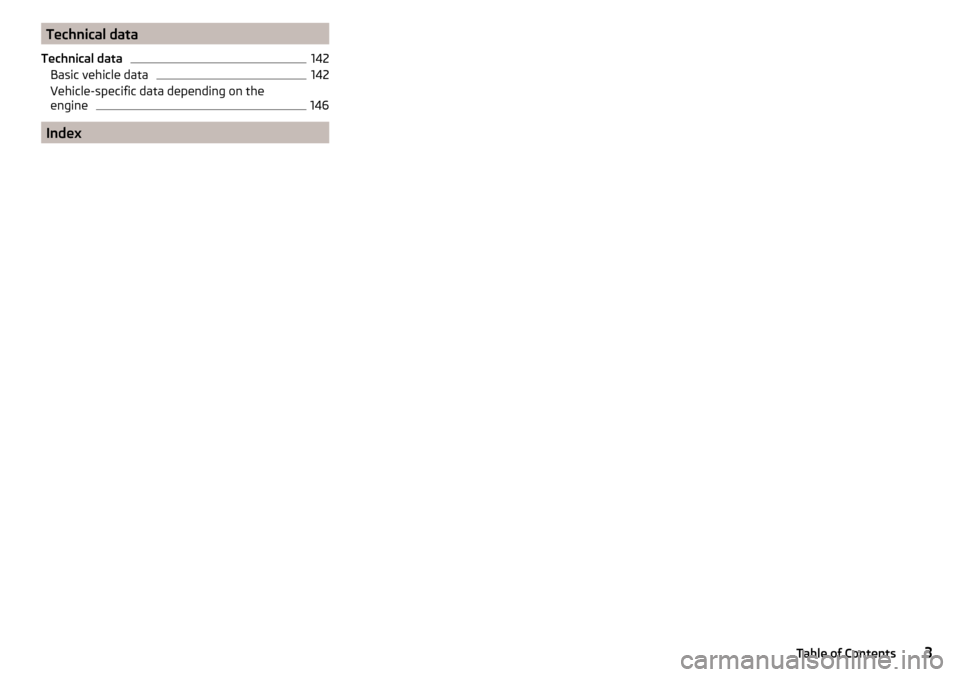
Technical data
Technical data142
Basic vehicle data
142
Vehicle-specific data depending on the
engine
146
Index
3Table of Contents
Page 6 of 160
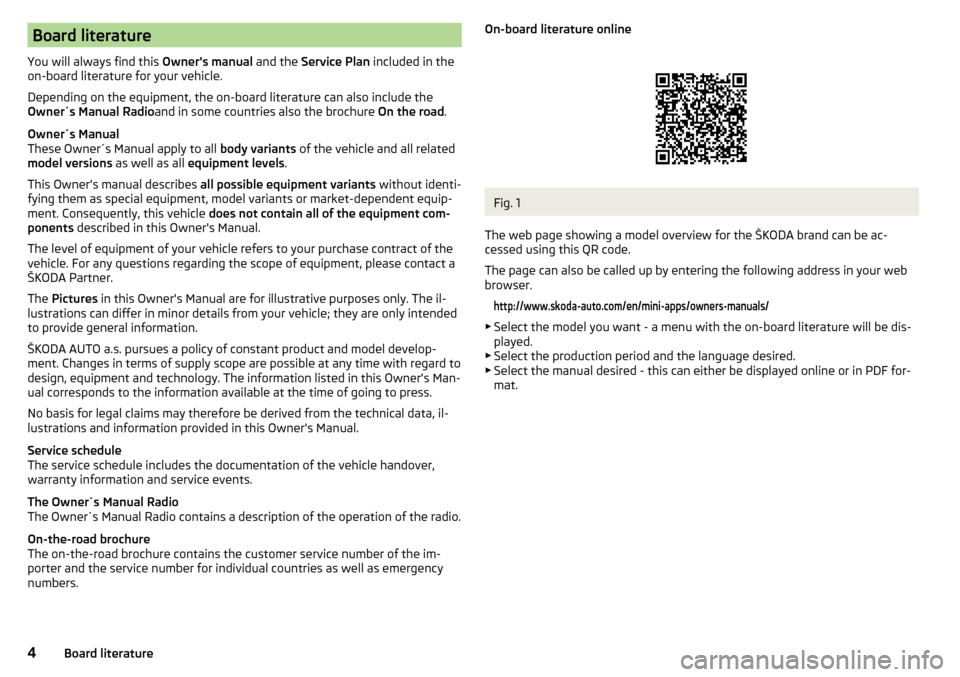
Board literature
You will always find this Owner's manual and the Service Plan included in the
on-board literature for your vehicle.
Depending on the equipment, the on-board literature can also include the
Owner´s Manual Radio and in some countries also the brochure On the road.
Owner´s Manual
These Owner´s Manual apply to all body variants of the vehicle and all related
model versions as well as all equipment levels .
This Owner's manual describes all possible equipment variants without identi-
fying them as special equipment, model variants or market-dependent equip-
ment. Consequently, this vehicle does not contain all of the equipment com-
ponents described in this Owner's Manual.
The level of equipment of your vehicle refers to your purchase contract of the
vehicle. For any questions regarding the scope of equipment, please contact a
ŠKODA Partner.
The Pictures in this Owner's Manual are for illustrative purposes only. The il-
lustrations can differ in minor details from your vehicle; they are only intended
to provide general information.
ŠKODA AUTO a.s. pursues a policy of constant product and model develop-
ment. Changes in terms of supply scope are possible at any time with regard to
design, equipment and technology. The information listed in this Owner's Man-
ual corresponds to the information available at the time of going to press.
No basis for legal claims may therefore be derived from the technical data, il-
lustrations and information provided in this Owner's Manual.
Service schedule
The service schedule includes the documentation of the vehicle handover,
warranty information and service events.
The Owner´s Manual Radio
The Owner´s Manual Radio contains a description of the operation of the radio.
On-the-road brochure
The on-the-road brochure contains the customer service number of the im-
porter and the service number for individual countries as well as emergency
numbers.On-board literature onlineFig. 1
The web page showing a model overview for the ŠKODA brand can be ac-
cessed using this QR code.
The page can also be called up by entering the following address in your web
browser.
http://www.skoda-auto.com/en/mini-apps/owners-manuals/
▶ Select the model you want - a menu with the on-board literature will be dis-
played.
▶ Select the production period and the language desired.
▶ Select the manual desired - this can either be displayed online or in PDF for-
mat.
4Board literature
Page 86 of 160

It recommended to open the windows or the doors of a vehicle for which the
interior has been strongly heated through the effect of direct sunlight in order
to allow the heated air to escape.
The cooling system should not be on if the windows are open.
Avoiding damage to your vehicle
Introduction
This chapter contains information on the following subjects:
Driving Tips
84
Driving through water
84
This section of the manual contains important information on preventing dam-
age to the vehicle while driving.
Driving Tips
Only drive on such roads and in such terrain, which match the vehicle parame-
ters » page 142 , Technical data as well as your driving skills.
The driver is always responsible for deciding whether the vehicle can handle
travelling in the given terrain.
WARNING■ Always adjust your driving to the current terrain and weather conditions.
Excessive speed or incorrect driving manoeuvres can cause damage to the
vehicle and lead to serious injuries.■
Combustible objects such as dry leaves or twigs caught under the base of
the vehicle could ignite on hot vehicle parts - risk of fire!
CAUTION
■ Pay attention to the ground clearance of the vehicle! When driving over ob-
jects which are larger than the ground clearance, the vehicle can get damaged.■
Any objects that get trapped under the vehicle floor must be removed as
soon as possible. These objects can damage the fuel lines, the brake system,
seals and other parts of the vehicle.
■
Drive slowly in unknown terrain and watch out for unexpected obstacles,
such as potholes, rocks, stumps, etc.
■
Check up on confusing sections of unpaved roads before travelling on them
and consider whether such travelling is possible without risk.
Driving through waterFig. 96
Maximum permissible water lev-
el when driving through water
The following instructions must be observed if vehicle damage is to be avoided
when driving through water (e.g. flooded roads).
›
Therefore determine the depth of the water before driving through bodies of
water.
The water level must not reach above the web of the lower beam » Fig. 96.
›
Do not drive any faster than at a walking speed.
At a higher speed, a water wave can form in front of the vehicle, which can
cause water to penetrate into the engine's air induction system or other parts
of the vehicle.
›
Never stop in the water, do not reverse and do not switch the engine off.
CAUTION
■ Should water penetrate into the intake system of the engine, there is a
threat of serious damage being incurred by the engine parts!■
When driving through water, some vehicle parts such as chassis, electrics or
transmission can be severely damaged.
■
Oncoming vehicles can generate water waves which can exceed the permis-
sible water level for your vehicle.
■
Potholes, mud or rocks can be hidden under the water, making it difficult or
impossible to drive through the body of water.
■
Do not drive through salt water, as the salt can cause corrosion. An vehicle
coming into contact with salt water is to be thoroughly rinsed with fresh wa-
ter.
84Driving
Page 144 of 160

Technical data
Technical data
Basic vehicle data
Introduction
This chapter contains information on the following subjects:
Vehicle characteristics
142
Operating weight
143
Payload
143
Measurement of fuel consumption and CO 2 emissions according to ECE
Regulations and EU Directives
143
Dimensions
144
Departure angle
145
The details given in the vehicle's technical documentation always take prece-
dence over the details in the Owner's Manual.
The listed performance values were determined without performance-reduc- ing equipment, e.g. air conditioning system.
The values given have been determined in accordance with regulations and in
conditions prescribed by legal or technical provisions for determining the oper-
ating and technical data of vehicles.
Vehicle characteristics
Fig. 149
Vehicle data sticker/type plate
Vehicle data sticker
The vehicle data sticker » Fig. 149 - is located on the base of the luggage
compartment and is also stuck into the service schedule.
The vehicle data sticker contains the following data. Vehicle identification number (VIN)
Vehicle type
Gearbox code/paint number/interior equipment/engine output/engine
code
Partial vehicle description
Type plate
The type plate » Fig. 149 -
is located at the bottom of the B-pillar on the left
driver's side.
The type plate contains the following data. Manufacturer
Vehicle identification number (VIN)
Maximum permissible gross weight
Maximum permissible front axle load
Maximum permissible rear axle load
Vehicle identification number (VIN)
The vehicle identification number - VIN (vehicle body number) is stamped into
the engine compartment on the right hand suspension strut dome. This num-
ber is also located on a sign on the lower left hand edge below the windscreen
(together with a VIN bar code), and on the type plate.
Engine number
The engine number (three-digit code letter and serial number) is stamped on the engine block.
Supplementary Information (applies to Russia)
The full type approval number of the means of transport is indicated in the
registration documents, field 17.WARNINGDo not exceed the specified maximum permissible weights – risk of acci-
dent and damage!123456789142Technical data
Page 145 of 160

Operating weight
The value represents the lightest possible vehicle weight without any addi-
tional equipment that would add to the weight, e.g. air conditioning, spare
wheel.
The specified operating weight is for orientation purposes only.
The operating weight also contains the weight of the driver (75 kg), the weight
of the operating fluids, the tool kit, and a fuel tank filled to 90 % capacity.EngineTransmissionOperating weight (kg)1.0 l/44 kW MPIMT929AT9321.0 l/44 kW MPI Green tecMT940AT9311.0 l/55 kW MPIMT929AT9321.0 l/55 kW MPI Green tecMT940AT9311.0 l/50 kW MPI G-TECMT1031
Note
If required, you can find out the precise weight of your vehicle at a specialist
garage.
Payload
It is possible to calculate the approximate maximum payload from the differ-
ence between the permissible total weight and the operating weight.
The payload consists of the following weights.
▶ The weight of the passengers.
▶ The weight of all items of luggage and other loads.
▶ The weight of the roof, including the roof rack system.
▶ The weight of the equipment that is excluded from the operating weight.
Measurement of fuel consumption and CO
2 emissions according to
ECE Regulations and EU Directives
The data on fuel consumption and CO 2 emissions were not available at the
time of going to press.
The data on fuel consumption and CO 2 emissions are given on the ŠKODA
websites or in the sales and technical vehicle documentation.
The measurement of the intra-urban cycle begins with a cold start of the en-
gine. Afterwards urban driving is simulated.
In the extra-urban driving cycle, the vehicle is accelerated and decelerated in
all gears, corresponding to daily routine driving conditions. The driving speed
varies between 0 and 120 km/h.
The calculation of the combined fuel consumption considers a weighting of
about 37 % for the intra-urban cycle and 63 % for the extra-urban cycle.
Note
■ The fuel consumption and emission levels given on the ŠKODA websites or in
the commercial and technical vehicle documentation have been established in
accordance with rules and under conditions that are set out by legal or techni-
cal rules for the determination of operational and technical data of motor vehi-
cles.■
Depending on the extent of the equipment, the driving style, traffic condi-
tions, weather influences and vehicle condition, consumption values can in
practice result in fuel economy figures in the use of the vehicle that differ from
the fuel consumption values listed on the ŠKODA websites or in the commer-
cial and technical vehicle documentation.
143Technical data
Page 146 of 160
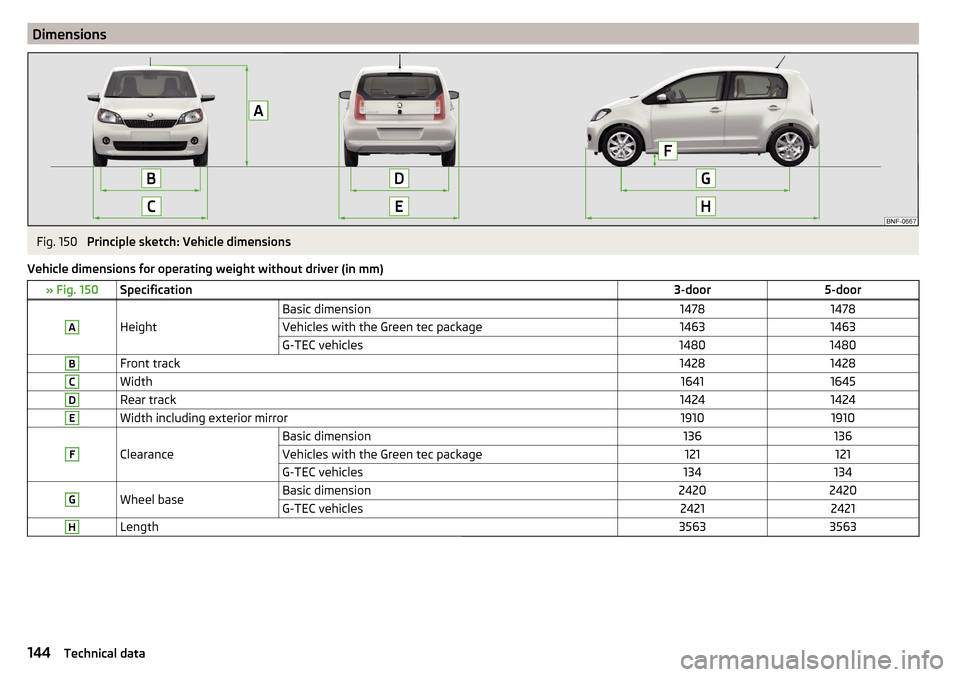
DimensionsFig. 150
Principle sketch: Vehicle dimensions
Vehicle dimensions for operating weight without driver (in mm)
» Fig. 150Specification3-door5-doorA
Height
Basic dimension14781478Vehicles with the Green tec package14631463G-TEC vehicles14801480BFront track14281428CWidth16411645DRear track14241424EWidth including exterior mirror19101910F
Clearance
Basic dimension136136Vehicles with the Green tec package121121G-TEC vehicles134134GWheel baseBasic dimension24202420G-TEC vehicles24212421HLength35633563144Technical data
Page 147 of 160
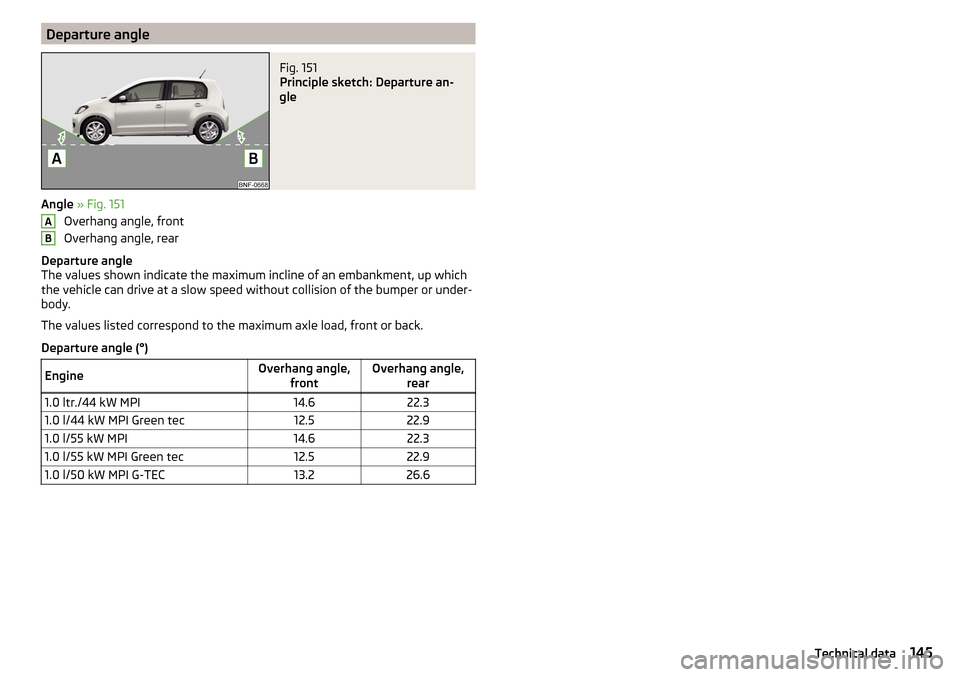
Departure angleFig. 151
Principle sketch: Departure an-
gle
Angle » Fig. 151
Overhang angle, front
Overhang angle, rear
Departure angle
The values shown indicate the maximum incline of an embankment, up which
the vehicle can drive at a slow speed without collision of the bumper or under-
body.
The values listed correspond to the maximum axle load, front or back.
Departure angle (°)
EngineOverhang angle, frontOverhang angle, rear1.0 ltr./44 kW MPI14.622.31.0 l/44 kW MPI Green tec12.522.91.0 l/55 kW MPI14.622.31.0 l/55 kW MPI Green tec12.522.91.0 l/50 kW MPI G-TEC13.226.6AB145Technical data
Page 148 of 160

Vehicle-specific data depending on the engine
Introduction
This chapter contains information on the following subjects:
1.0 ltr./44 kW MPI engine
146
1.0 l/55 kW MPI engine
146
1.0 l/50 kW MPI G-TEC engine
146The values given have been determined in accordance with regulations and in
conditions prescribed by legal or technical provisions for determining the op-
erating and technical data of vehicles.The emissions standard is detailed in the technical vehicle documentation as
well as in the certificate of conformity (so-called COC document), which can
be obtained from a ŠKODA partner a)
.a)
Only valid for some countries and some models.
1.0 ltr./44 kW MPI engineOutput (kW/rpm)44/5000Maximum torque (Nm at rpm)95/3000Number of cylinders/displacement (cm 3
)3/999TransmissionMTMT (Green tec)ATASG (Green tec)Top speed (km/h)160161160161Acceleration 0-100 km/h (s)14.414.415.315.3
1.0 l/55 kW MPI engine
Maximum torque (Nm at rpm)95/3000Output (kW/rpm)55/6200Number of cylinders/displacement (cm 3
)3/999TransmissionMTMT (Green tec)ATASG (Green tec)Top speed (km/h)171172171172Acceleration 0-100 km/h (s)13.213.213.913.9
1.0 l/50 kW MPI G-TEC engine
Output (kW/rpm)50/6200Maximum torque (Nm at rpm)90/3000Number of cylinders/displacement (cm 3
)3/999TransmissionMTTop speed (km/h)164Acceleration 0-100 km/h (s)16.3146Technical data
Page 155 of 160
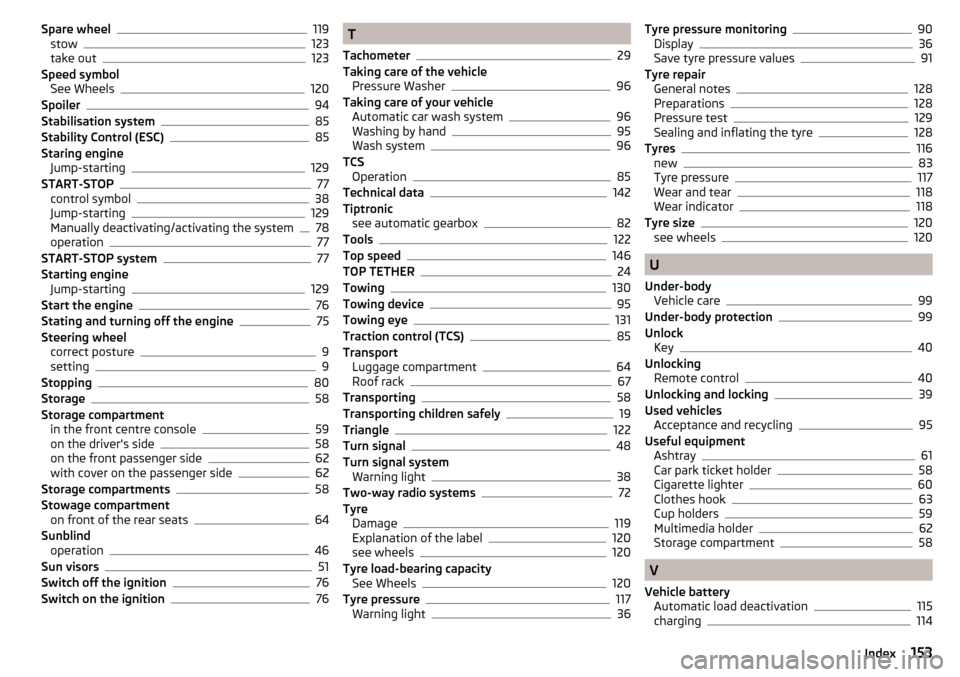
Spare wheel119
stow123
take out123
Speed symbol See Wheels
120
Spoiler94
Stabilisation system85
Stability Control (ESC)85
Staring engine Jump-starting
129
START-STOP77
control symbol38
Jump-starting129
Manually deactivating/activating the system78
operation77
START-STOP system77
Starting engine Jump-starting
129
Start the engine76
Stating and turning off the engine75
Steering wheel correct posture
9
setting9
Stopping80
Storage58
Storage compartment in the front centre console
59
on the driver's side58
on the front passenger side62
with cover on the passenger side62
Storage compartments58
Stowage compartment on front of the rear seats
64
Sunblind operation
46
Sun visors51
Switch off the ignition76
Switch on the ignition76
T
Tachometer
29
Taking care of the vehicle Pressure Washer
96
Taking care of your vehicle Automatic car wash system
96
Washing by hand95
Wash system96
TCS Operation
85
Technical data142
Tiptronic see automatic gearbox
82
Tools122
Top speed146
TOP TETHER24
Towing130
Towing device95
Towing eye131
Traction control (TCS)85
Transport Luggage compartment
64
Roof rack67
Transporting58
Transporting children safely19
Triangle122
Turn signal48
Turn signal system Warning light
38
Two-way radio systems72
Tyre Damage
119
Explanation of the label120
see wheels120
Tyre load-bearing capacity See Wheels
120
Tyre pressure117
Warning light36
Tyre pressure monitoring90
Display36
Save tyre pressure values91
Tyre repair General notes
128
Preparations128
Pressure test129
Sealing and inflating the tyre128
Tyres116
new83
Tyre pressure117
Wear and tear118
Wear indicator118
Tyre size120
see wheels120
U
Under-body Vehicle care
99
Under-body protection99
Unlock Key
40
Unlocking Remote control
40
Unlocking and locking39
Used vehicles Acceptance and recycling
95
Useful equipment Ashtray
61
Car park ticket holder58
Cigarette lighter60
Clothes hook63
Cup holders59
Multimedia holder62
Storage compartment58
V
Vehicle battery Automatic load deactivation
115
charging114
153Index